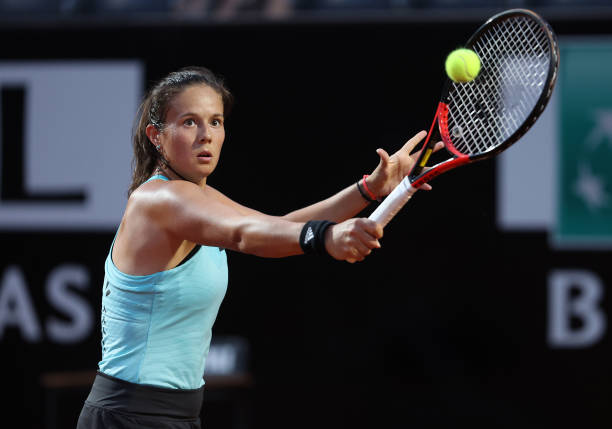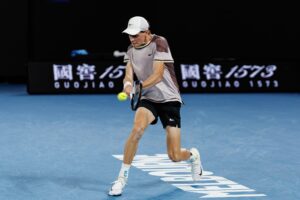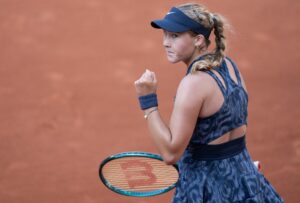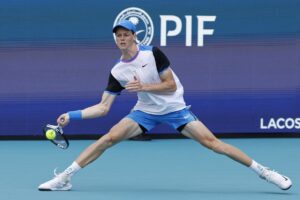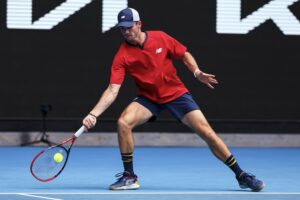Daria Kasatkina is one of the great artists of women’s tennis, a player with multiple shots and skills that stand in direct contrast to the “monogame” of so many other players (both female and male) from Russia and the old Soviet Bloc. Now, four years on from first reaching the top ten of women’s tennis after a spectacular performance at that year’s French Open, she might just be about to return to those dizzying heights in time for another deep run at Roland Garros.
Not Artistic Or Expansive In Personality
Unlike so many of the great tennis artists, from Helen Wills to Nicola Pietrangeli to Roger Federer, Kasatkina does not appear to have the outgoing, expansive personality to match her inventive, even at times miraculous, play. Instead, she seems to have a perpetual look of surprise on her face, as if she herself cannot quite believe some of the shots that she is able to play, or some of the misses she has made.
Kasatkina did not just surprise herself in Rome last week, as she reached the semi-finals and actually held a match-point over Ons Jabeur before eventually losing a wonderful match for tennis purists in three sets, 4-6, 1-6, 5-7. The Tunisian, who had won in Madrid the week before, maintained her own recent spectacular run of form, to win after an apparently unending succession of drop shots and deft volleys from both players, but there was no doubt that Rome 2022 was Kasatkina’s most impressive tournament in ages. It was not just her first WTA 1000 semi-final but a reminder for all tennis fans, and perhaps even Kasatkina herself, that she can compete with the very best players in women’s tennis.
Winning The 2014 Junior French Open And Quickly Entering The World’s Top Ten
Even in Russia, which produces so many fine tennis players (none of whom will play at Wimbledon this year, unless the tournament drops its ban on Russian and Belarusian players after Vladimir Putin’s invasion of Ukraine), Kasatkina had always been seen as a potential star. Indeed, she was part of a particularly impressive Russian one-two in Paris in 2014, when she and Andrey Rublev won the Junior French Open titles, and she maintained her upward trajectory when she turned professional later that year.
Indeed, Kasatkina’s initial ascent up the WTA rankings was so swift that in retrospect it is perhaps not so surprising that she ended up some suffering some form of altitude sickness and almost crashed back down to earth. Her breakthrough performance at a Major also came at Roland Garros, four years after her Junior triumph, when she reached the last eight of the main draw in 2018. The highlight of that run to the French quarterfinals was a fourth-round demolition of Caroline Wozniacki, who had won the Australian Open less than six months earlier, when Kasatkina’s full and dazzling repertoire of dices and slices, feints and swerves, was on display for all to see.
Nevertheless, even during that breakthrough at a Major when she was only just 21, the two obvious deficiencies in Kasatkina’s game – the lack of a strong first serve and a worrying tendency towards excessive self-criticism – were on display. Her quarter-final against Sloane Stephens was almost the exact opposite of her destruction of Wozniacki, as she lost feebly in straight sets. And although she did go on to make it back-to-back quarterfinals at a Major by reaching the last eight at Wimbledon later that summer, in the process proving that she could play on all surfaces, the seeds of her subsequent decline had already been sown.
Decline And Fall Down The Rankings
Having reached two Major quarterfinals in succession and entered the world’s top 10 in 2018, it seemed that Kasatkina was on an inevitable ascent that would soon see her swap. a Junior triumph at a Major for a Senior one, or at least another serious run. However, the increasing frailty of her serve (the only shot on a tennis court that she didn’t seem to possess) and the unremitting grind of the tour began to take their toll, and she began a slow slide back down the rankings throughout 2019 and 2020. That was only accentuated by the start of the Coronavirus pandemic in the spring of 2020, when, like so many tennis players and sportspeople in general, she barely played at all for several months. And even when the tennis tours resumed, she still seemed unable to recapture the youthful brilliance or verve of Paris 2014 or Paris 2018.
In commentating on her resurgence in Rome last week, Amazon Prime Video’s Mark Petchey even suggested that Kasatkina’s decline in form and rankings had been so steep that she had contemplated quitting tennis, the sport she seemed to be such a natural at. According to Petchey, it was only a change of coach, to Carlos Martinez (who had previously worked with Major-winner Svetlana Kuznetsova, among others), and the friendship of other Russian players and their partners on tour, particularly Veronika Khachanov (Karen Khachanov’s wife), that had enabled this rather quiet, even shy young woman to rediscover her love for the sport.
A Resurgence That Could Be Completed At The 2022 French Open
Gradually, under the tutelage of Martinez and with the support of her compatriots, Kasatkina has rebuilt her game, in particular improving her serve, and really toughened up mentally. That was evident in a team context at the end of 2021, when she was part of the Russian team that won the inaugural Billie Jean King Cup. However, she showed in Rome last week that she could also compete again as an individual at the very top, in particular in her round-of-16 defeat of Spain’s Paula Badosa.
https://www.youtube.com/watch?v=K_LfHD_CT_Q
Badosa was probably the breakthrough woman player of 2021, a year that culminated in her triumph at Indian Wells and appearance at the end-of-season WTA Finals in Mexico. She has largely maintained that form so far this season, as she has risen to No.2 in the rankings, behind only the currently dominant World No.1 Iga Swiatek, who defeated her in Stuttgart. Consequently, when Badosa played Kasatkina in Rome late last Thursday, in cold, damp conditions that made the ball and the court incredibly difficult to hit through, it was expected that if anyone would mentally disintegrate (to use the Australian cricketing term for sporting self-destruction), it would surely be Kasatkina.
However, in what amounted to an almost complete role reversal, it was Kasatkina who somehow kept her cool and somehow kept returning the ball one more time, before Badosa inevitably went for too much power in the conditions and fired the ball long. Having led 3-0 in the first set and appeared about to bagel Kasatkina, Badosa no longer seemed able to serve at all and Kasatkina eventually won in straight sets, 6-4, 6-4.
The victory over such a redoubtable opponent as Badosa, even if the Spaniard was definitely having an off-night, should have proved to Kasatkina conclusively that she can still compete with, and even defeat, the best women in the world. She was similarly impressive against Switzerland’s Jil Teichmann in the quarter-final, even if Teichmann did have to retire through injury early in the second set. And if ultimately Kasatkina could not beat Jabeur, one of the form players of the season so far, she pushed the Tunisian all the way before eventually losing narrowly.
As a result of her run to the Rome semi-finals, Kasatkina is now back in the world’s top 20 and is again the Russian No.1. Because Wimbledon is not expected to overturn its ban on Russian and Belarussian players, despite a threat from both the WTA and the ATP that it could lose all its ranking points and effectively be classed as an exhibition event, for Kasatkina and all the other Russian and Belarusian players, all eyes will be on the French Open, which starts this Sunday. She has history at Roland Garros, having won the girls’ title in 2014 and then reached the last eight of the main draw in 2018. Four years on from that last landmark, and having experienced the kind of slide down the rankings that could have destroyed many lesser players, Kasatkina might just be about to make it a hat-trick of impressive performances in Paris.
Main Photo:


